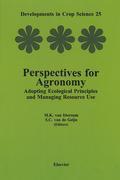During the 4th ESA-Congress, held in the Netherlands, 7-11 July 1996, a new perspective for agronomy emerged. Various contributions demonstrate the need for a new role of agronomy and its tools. In recent decades, agriculture has evolved from an activity with mainly productivity aims, into an issue conciliating environmental, agricultural, and economic and social objectives. Placing agriculture in such a broadened perspective requires a different agronomy, with new tools and approaches at a range of aggregration levels. It calls for detailed knowledge concerning the functioning, productivity and ecological relationships of agricultural plants and crops. In addition, it calls for a constant update and synthesis of existing and newly generated knowledge, the design of new ideotypes and genotypes, new production technologies, cropping systems, farming systems and agro-ecological land use systems. This proceedings book presents a set of case studies illustrating the various agronomic tools that can be used for specific agronomic questions. The case studies are grouped in sections illustrating relevant subquestions in developing an agriculture with broadened objectives. The book starts with an introductory paper on the role of agronomy in research and education in Europe. The second section deals with agricultural land use, food security and environment. This is followed by a set of papers describing experimental research and modeling approaches used to design new ideotypes of crops, including physiological properties in relation to growth factors such as radiation, CO2, temperature and water. Sustained soil fertility directly links to nutrient cycling and soil organic matter. A selected set of papers addresses the improvements in resource use efficiency and as such their contribution towards economic, environmental and agricultural objectives. The final section addresses the design of integrated and ecological arable farming systems. It highlights the role of prototyping


